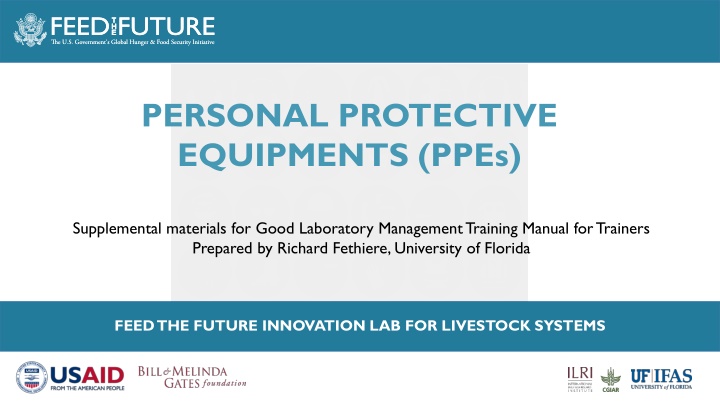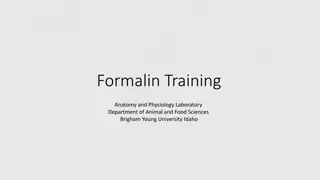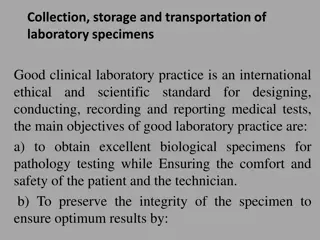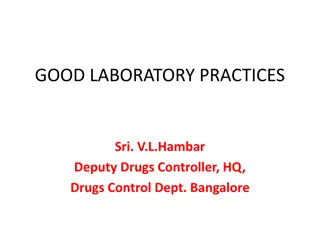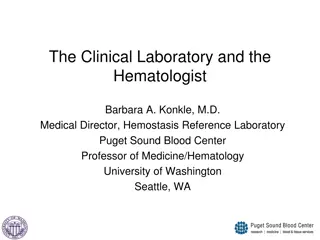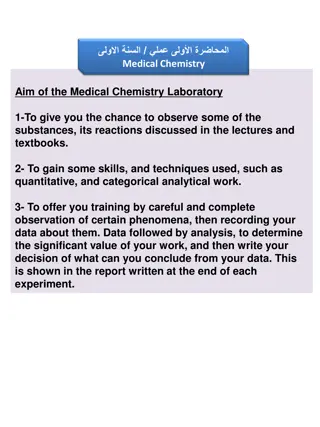Best Practices for Laboratory Safety and Management
Promoting a safe laboratory environment involves following safety codes and assigning responsibilities for practices like hazard awareness, equipment use, and PPE. Good laboratory practices include proper storage and handling of hazardous chemicals, with a focus on flammable, corrosive, reactive, and toxic substances. Utilizing protective gloves is emphasized for working with hazardous materials to ensure safety and minimize risks.
Download Presentation

Please find below an Image/Link to download the presentation.
The content on the website is provided AS IS for your information and personal use only. It may not be sold, licensed, or shared on other websites without obtaining consent from the author.If you encounter any issues during the download, it is possible that the publisher has removed the file from their server.
You are allowed to download the files provided on this website for personal or commercial use, subject to the condition that they are used lawfully. All files are the property of their respective owners.
The content on the website is provided AS IS for your information and personal use only. It may not be sold, licensed, or shared on other websites without obtaining consent from the author.
E N D
Presentation Transcript
PERSONAL PROTECTIVE EQUIPMENTS (PPEs) Supplemental materials for Good Laboratory Management Training Manual for Trainers Prepared by Richard Fethiere, University of Florida FEED THE FUTURE INNOVATION LAB FOR LIVESTOCK SYSTEMS Photo Credit Goes Here
Safety Safety: Protective gloves Background Safety: PPE Disposal of hazardous waste
SAFETY Every lab should aim to promote a safe and healthy environment, by providing programs and services that minimizes community risks related to: SAFETY HEALTH ENVIRONMENT Safety codes and standards should be followed by all individuals associated with the lab and institution
SAFETY-RELATED PRACTICES There should be a clear assignments of responsibilities for appropriate safety- related practices: Responsible of general safety Responsible of safety education Responsible of safety rules compliance Consider individual responsibilities and hierarchy
ASSIGNMENTS OF RESPONSIBILITIES There should be clear assignments of responsibilities for appropriate safety-related practices: Hazard awareness Safety equipment use (first aid, spill, and fire kits) Personal Protective Equipment (lab coats, gloves, goggles, respirators, etc.)
GOOD LABORATORY PRACTICES Procedures for storing and handling specific types of chemicals should be established and followed, particularly for: Flammable chemicals Corrosive Chemicals Reactive chemicals Highly toxic chemicals Acetone Alcohol Toluene Sulfuric acid Hydrofluoric acid Sodium hydroxide Peroxides Perchlorates Hydrides Arsenic Hydrogen cyanide Chlorine
GOOD LABORATORY PRACTICES (2) These chemicals must be: Clearly labeled Properly stored Appropriately disposed An emergency call list should be established in case of emergencies
SAFETY: PROTECTIVE GLOVES Shall be worn when working with hazardous materials IMPORTANT: No gloves will protect from every chemical Gloves must be selected based on the intended use AND considering the user (latex allergies) CHECK GLOVE COMPATIBILITY CHARTS TO MAKE SURE YOU RE USING THE CORRECT ONES
SAFETY: PPE Eye protection: Shall be worn at ALL TIMES when working with Chemical, biological, radioactive substances Prescription glasses won t provide adequate protection from injury or exposure Safety goggles or face shields: Must be used when there s a risk of splashing, violent reactions, or flying particles Specific goggles shall be worn if working with laser, ultraviolet, or other light sources Contact lenses should not be worn in lab work areas. When required, safety goggles should be worn at ALL TIMES
SAFETY: PPES Lab coats or gowns: Are required to be used over street clothes or exposed skin when working with: Chemical substances Biological substances Radioactive substances Should be always buttoned up and should cover the user to below the knees
SAFETY: PPES Facemasks: May be necessary if working on a dusty environment (grinding samples) Respirators: May be required if a hazard assessment determines it
DISPOSAL OF HAZARDOUS WASTE Chemical waste must be properly labeled and identified Chemicals (including liquids with pH<5) should not be disposed down drains, trash, or by evaporation Chemical wastes are required to be held in accumulation areas until pickup Each lab must have a waste manager
Consult the Good Laboratory Management Training Manual for Trainers https://livestocklab.ifas.ufl.edu/resources/glp/ Direct link to manual in PDF: https://livestocklab.ifas.ufl.edu/media/livestocklabifasufledu/pdf-/MANUAL- Fethiere_UF_Good-lab-management-practices_2022.pdf
Feed the Future Innovation Lab for Livestock Systems https://livestocklab.ifas.ufl.edu/ (Subscribe to newsletter) livestock-lab@ufl.edu Disclaimer This work was funded by the United States Agency for International Development (USAID) Bureau for Food Security under Agreement #AID-OAA-L-15-00003 as part of Feed the Future Innovation Lab for Livestock Systems, and by the Bill & Melinda Gates Foundation OPP#1175487. Any opinions, findings, conclusions, or recommendations expressed here are those of the authors alone.
